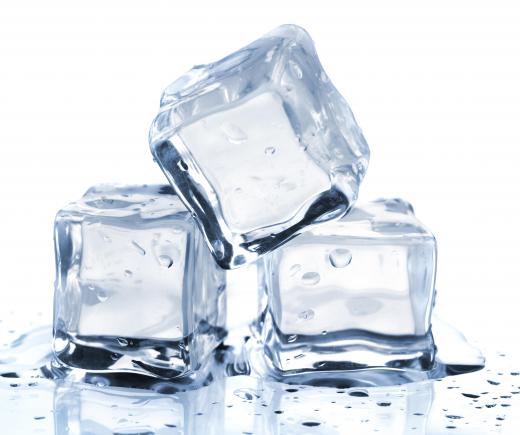What Is an Ice Point?
 Mary McMahon
Mary McMahon
The ice point is a temperature at normal atmospheric pressure at which it is possible for solid and liquid water to coexist in a state of thermal equilibrium. Many temperature scales have historically utilized the ice point of water for calibration. In Fahrenheit, this temperature is 32 degrees, while the Celsius scale places it at zero degrees. The point of icing is not the same thing as the freezing point, an important distinction, especially among quibbling and precise scientists.
When discussing the freezing point of water, people often refer to the temperatures of the ice point, because water does in fact freeze at this point. However, several factors can influence the freezing point of water, including salinity. Saltwater can actually become supercooled, meaning that it passes below the point at which it would normally freeze before it freezes solid. Many substances possess the capacity to become supercooled under certain conditions.

A closely related concept is the triple point, the temperature at which solid, liquid, and gaseous water can all exist together. This measurement is only a fraction of a degree higher than the ice point, but it is the preferred method of calibration for precise temperature scales and scientific instruments in most regions of the world. Triple points can also be found for many other substances, but since water is an abundant and well-known chemical compound, it is the preferred standard to use.
This temperature also reflects a phase change barrier, at which water passes from a primarily liquid state to a mostly solid state. Phase changes also occur as temperatures rise and water begins to turn into steam because it cannot maintain a liquid state. The phase change barriers for many substances can be profoundly influenced by the amount of atmospheric pressure, which is why things like water behave differently at high altitude than they do at low altitude.
Knowing the ice point is critical from a number of perspectives. It's an important benchmark in the determination of temperatures, and it can also play a role in scientific research and experiments. Meteorologists, navigators, and public safety officials also have an interest in the ice point, as it can influence environmental conditions in cold regions of the world. People may also use this temperature at home in the calibration of thermometers, ensuring that the instruments measure the temperature correctly by chilling water to the ice point, at which point a known temperature will be reached.
AS FEATURED ON:
AS FEATURED ON:











Discussion Comments
@sunnySkys - I had never heard of this point either. But will be now be using it for dinner conversation fun here in Greensboro, North Caroline.
In the winter, our temperature loves to hang right around the ice point and freezing point always leaving for fun predictions if there is going to be snow or not (a.k.a. if there is going to be school or not).
Often we end of having rain, and then it freezes over night and then changes to snow so to give the ice a covering. Then it begins to rain as it warms up, but the ice is still there - and now I know another reason why it does that - when it is at the ice point both the rain and ice can coexist!
So to me it makes a difference as to safety if you live in a place that hangs around the icepoint and the freezing point. You have to understand that just because it is raining does not mean there is not any ice - so we are always careful when walking and on the roads.
@sunnySkys - What you said about half frozen lakes makes the ice point even more important, I think. That way people can know there is a big possibility that a lake won't be frozen all the way through and avoid walking or ice skating on it.
I can actually think of another example of water and ice existing at the same time. When I was in high school I hated waking up early and I would often sleep right through my alarm. I remember a few times running late and having to go to the bus stop with wet hair in the winter. The ends of my hair would get icy, and the rest of it wouldn't.
When I took science class, they never told us that water could exist in all three states at one time. I remember we had to memorize the freezing and boiling points of water though, and they were presented as absolute. I think this is really amazing though.
But now that I think about it, I suppose it makes sense. In the winter, a layer of ice can form on top of a lake, but there will be unfrozen water under it. This results in accidents from people falling through the ice into the water. So I guess that is proof right there that water can exist in at least two states at the same time.
Post your comments